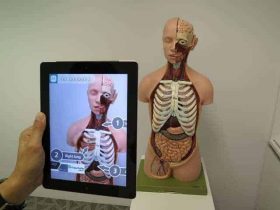Top 10 Real-World Applications of Augmented Reality (AR)
Augmented Reality (AR) is reshaping the way we interact with the world around us. By blending digital visuals and audio with the physical environment, AR enhances real-world experiences through interactive, immersive elements.
With its rapid evolution and expanding capabilities, AR is no longer limited to gaming or fun filters—it’s now a powerful tool used across industries like healthcare, education, retail, logistics, and more.
What is Augmented Reality?
AR overlays computer-generated images, text, or sounds onto the real-world environment using devices such as smartphones, tablets, smart glasses, or headsets. It combines advanced technologies like image recognition, speech detection, motion tracking, and 3D modeling to offer an enriched experience in real-time.
From virtual try-ons to real-time navigation support, AR’s real-world potential is truly transformative.
Top 10 Real-World Applications of Augmented Reality
1. AR in Business (Cosmetics & Retail Products)
Many top cosmetic brands now use AR to let customers virtually try makeup—lipstick, eyeliner, foundation, and more—via their smartphones. This not only enhances the customer experience but also boosts engagement and sales.
Example:
- L’Oréal and Sephora offer virtual try-on tools.
- Rolex allows users to visualize watches on their wrists using AR apps.
2. Augmented Reality in Healthcare
AR is revolutionizing medical training, diagnosis, and patient care. It helps:
- Train surgeons with virtual models.
- Guide complex procedures in real-time.
- Enable telemedicine with AR overlays.
Benefit:
Real-time data visualization improves diagnostics and treatment precision.
3. AR in Entertainment
While gaming remains a major domain for AR, it’s now being used in interactive books, children’s learning apps, and even theater productions.
Examples:
- Pokemon GO brought AR gaming mainstream.
- Apps like BIC DrawyBook combine storytelling with interactive AR visuals.
4. AR in Retail
AR enables customers to preview products in their own space—like furniture in a room or clothes on their body—before making a purchase.
Example:
- IKEA Place app lets users visualize furniture in their home using AR.
- Harley Davidson allows bike customization with AR features.
5. AR in Tourism
AR adds a new dimension to travel experiences by overlaying historical facts, directions, or 3D reconstructions of landmarks onto real-world locations.
Example:
- TripAdvisor and Lonely Planet offer AR guides.
- Tourists can point their phones at sites to see real-time historical details.
6. AR for Public Safety & Emergency Response
AR can be used during emergencies like earthquakes or fires to:
- Help locate trapped individuals.
- Provide rescuers with building layouts.
- Allow loved ones to track each other’s location in real-time.
This makes AR a valuable asset for first responders and disaster management.
7. AR in Classroom Education
Modern classrooms are embracing AR to make learning interactive and engaging. AR brings subjects like science, history, and music to life with 3D models and animations.
Example:
- Aurasma (now HP Reveal) allows educators to overlay digital content on physical materials.
- Students can explore planets, musical instruments, and more via AR apps.
8. AR in Logistics & Warehousing
AR helps streamline logistics operations by:
- Optimizing warehouse navigation.
- Displaying picking instructions through AR glasses.
- Reducing worker error and boosting productivity.
Example:
- Companies like DHL and FedEx have implemented AR in their warehouse management systems.
9. AR in Field Service & Maintenance
Field technicians use AR headsets or mobile apps to receive live instructions, diagnose issues, and fix complex machinery more efficiently.
Benefits:
- Reduced service time
- Improved accuracy
- Fewer repeat visits
10. AR in Repair & Equipment Maintenance
AR is widely used in industries like automotive and medical equipment for real-time repair guidance. By wearing AR glasses, technicians can view step-by-step instructions overlaid on the machine.
Use Cases:
- Car engine repair
- MRI machine maintenance
- Aircraft inspections
Future of AR: Beyond Smartphones
Today, AR mostly runs on smartphones and tablets, but the future promises more advanced wearables—smart glasses, AR contact lenses, and even AR-enabled implants. Companies are investing heavily to create more immersive experiences and enhance accessibility, especially for the visually impaired.
However, as AR grows, privacy and ethical concerns are also emerging. Devices like Google Glass sparked debates around surveillance and data misuse. As the technology advances, ensuring transparency and user consent will be crucial.
Final Thoughts
Augmented Reality is no longer a futuristic concept—it’s a present-day game changer. From improving business efficiency and customer engagement to enhancing education and healthcare, AR is transforming how we live, learn, shop, and work.
See Also:
Share Your Thoughts
What’s your favorite AR application in daily life? Let us know in the comments below!
Like This Content?
Subscribe to our YouTube Channel for the latest on IoT, AR, AI, and smart technologies.
Want to Contribute?
Got an innovative product or AR idea? Submit a guest post on IoTDunia and showcase it to our global tech-savvy audience!








Leave a Review